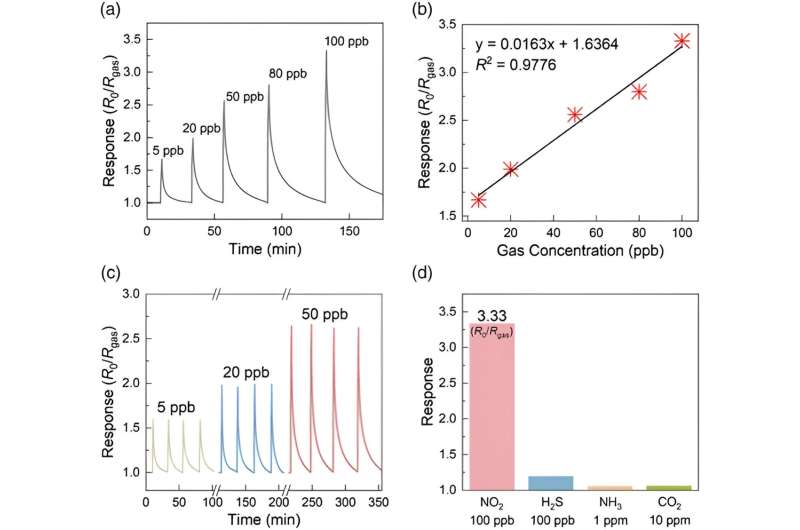This article has been reviewed according to Science X's editorial process and policies. Editors have highlighted the following attributes while ensuring the content's credibility:
fact-checked
trusted source
proofread
Novel toxic gas sensor improves the limit of nitrogen dioxide detection

Researchers at the Korea Research Institute of Standards and Science developed a toxic gas sensor with the world's highest sensitivity. This sensor can precisely monitor nitrogen dioxide (NO2), a toxic gas in the atmosphere, at room temperature with low power consumption and ultra-high sensitivity. It can be applied to diverse fields, such as detection of residual gases during semiconductor manufacturing process and research on electrolysis catalysts.
NO2, produced by the high-temperature combustion of fossil fuels and primarily emitted through automobile exhaust or factory smoke, contributes to an increase in mortality due to air pollution. In South Korea, the annual average concentration of NO2 in the air is regulated to be 30 ppb or lower by presidential decree. Highly sensitive sensors, therefore, are required to accurately detect gases at extremely low concentrations.
In recent times, the use of toxic gases that are potentially fatal to humans has been on the rise due to the development of high-tech industries, including semiconductor manufacturing. While some laboratories and factories have adopted semiconductor-type sensors for safety, the challenge lies in their low response sensitivity, making them unable to detect toxic gases that may even be perceptible to the human nose. To increase the sensitivity, they consume a lot of energy in the end because they must operate at high temperatures.
The newly developed sensor, a next-generation semiconductor-type toxic gas sensor based on advanced materials, exhibits significantly improved performance and usability compared to conventional sensors. With its outstanding sensitivity to chemical reactions, the new sensor can detect NO2 much more sensitively than previously reported semiconductor-type sensors, a sensitivity that is 60 times higher. Moreover, the novel sensor consumes minimal power operating at room temperature, and its optimal semiconductor manufacturing process enables large-area synthesis at low temperatures, thereby reducing fabrication costs.

The key to the technology lies in the MoS2 nanobranch material developed by KRISS. Unlike the conventional 2D flat structure of MoS2, this material is synthesized in a 3D structure resembling tree branches, thereby enhancing the sensitivity. Besides its strength of uniform material synthesis on a large area, it can create a 3D structure by adjusting the carbon ratio in the raw material without additional processes.
The KRISS Semiconductor Integrated Metrology Team has experimentally demonstrated that their gas sensor can detect NO2 in the atmosphere at concentrations as low as 5 ppb. The calculated detection limit of the sensor is 1.58 ppt, marking the world's highest level of sensitivity.
This achievement enables precise monitoring of NO2 in the atmosphere with low power consumption. The sensor not only saves time and cost but also offers excellent resolution. It is expected to contribute to research on improving atmospheric conditions by detecting annual average concentrations of NO2 and monitoring real-time changes.
Another characteristic of this technology is its ability to adjust the carbon content in the raw material during the material synthesis stage, thereby altering the electrochemical properties. This can be utilized to develop sensors capable of detecting gases other than NO2, such as residual gases produced during the semiconductor manufacturing processes. The excellent chemical reactivity of the material can also be exploited to enhance the performance of electrolysis catalysts for hydrogen production.
Dr. Jihun Mun, a senior researcher of the KRISS Semiconductor Integrated Metrology Team, said, "This technology, which overcomes the limitations of conventional gas sensors, will not only meet government regulations but also facilitate precise monitoring of domestic atmospheric conditions. We will continue follow-up research so that this technology can be applied to the development of various toxic gas sensors and catalysts, extending beyond the monitoring of NO2 in the atmosphere."
More information: Jeongin Song et al, MOCVD of Hierarchical C‐MoS2 Nanobranches for ppt‐Level NO2 Detection, Small Structures (2023). DOI: 10.1002/sstr.202200392





















